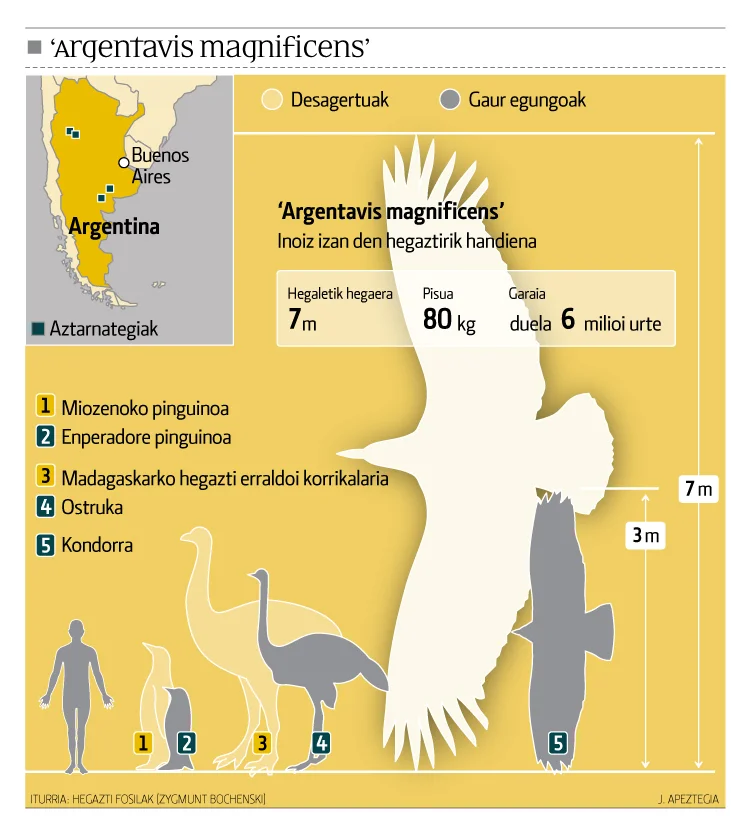The Argentavis Magnificens was the heaviest flight bird to ever exist
Advertisement
Argentavis Magnificens Facts
- Prey
- Rodents, armadillos, sloths, rabbits, other small mammals
- Fun Fact
- The Argentavis Magnificens was the heaviest flight bird to ever exist
- Other Name(s)
- Giant Teratorn
- Wingspan
- 20-25 feet
Argentavis Magnificens Physical Characteristics
View all of the Argentavis Magnificens images!
The Argentavis Magnificens had an impressive wingspan of up to 23 feet. That is about the same size as a small passenger plane!
Summary
The Argentavis Magnificens (literally translated to the Magnificent Argentine bird) was one of the largest birds ever to live. There are no modern-day birds to have a wingspan as large as the Argentavis Magnificens. Sometimes known as the Giant Teratorn, this species was found in central and northwestern Argentina, where a good sample of fossils has been obtained. These birds were known to inhibit the South American terrain about 6 million years ago in the late Miocene period. They went extinct about 10,000 years ago.
Scientific Name
The first specimen of this large bird was discovered by paleontologists Campbell and Tonni in 1980 and was named the “Argentavis” or “Argentina bird.” They belonged to an extinct family of predator birds called teratornis or “monster birds.” The Argentavis Magnificens is the heaviest known flying bird ever and was likely a close ancestor of the Andean condor, the heaviest non-extinct flying bird species.

This bird roamed the skies of South America from about 6 million years ago up until about 10,000 years ago. The most likely reason for this disappearance is climate change.
©1,676 × 1,800 pixels, file size: 744 KB, MIME type: image/jpeg
Description & Size
Belonging to the Argentavis genus, the Argentavis Magnificens was a massive bird with a wingspan of about 20-25 feet, the same size as a small airplane. These birds weighed about 150-200 pounds, almost the weight of a washing machine. They had an eagle-like beak filled with sharp teeth-like spikes, allowing them to feed on animals the size of a small dog. Our modern-day birds lost these teeth to the evolutionary process over time.
The Argentavis Magnificens spent most of its time in the air gliding. Its massive wingspan allowed it to flap its wings less when it was high in the air and slowly glide around, expelling less energy. Despite the collosol size of the bird, it did not weigh much due to the hollow bones found in most bird species.
Some other characteristics of the Argentavis Magnificens were as follows:
| Weight | 140 – 180 pounds |
| Wingspan | 19 – 26 ft |
| Top speed | 40-50 mph |
| Wing area | 75 squared feet |
| Body Length | 11.5 ft |
| Body Height | 5.6 ft – 6.5 ft |
Based on recent studies on Argentavis Magnificens via computer simulation, scientists believe this heavy bird could fly at a cruising speed as fast as 40-50mph.
Diet – What Did Argentavis Magnificens Eat?
The Argentavis Magnificens were large predatory birds with a large beak with many cone-shaped spikes, similar to teeth. They hunted small land animals and likely fed on larger animals’ corpses. When hunting, these birds could spot their prey from very high in the air. Once they located their prey, they would swoop down and grab them by the neck to kill them. Finally, they would swallow the prey whole as soon as possible without landing on the ground.
Their mouth structure suggested that they usually used their teeth to kill their prey and then swallowed it in large chunks instead of ripping the flesh. Their prey could include rodents, armadillos, small sloths, rabbits, and dead mammals.
The Argentavis Magnificens likely consumed about 5-10 pounds of meat per day since this was their primary source of nutrition.
Biologists have studied the remains of the Argentavis and made hypotheses on the creature’s diet. Still, this information is based on speculation on the animal’s habitat from the location of their fossils.
Habitat – When And Where It Lived
The Argentavis Magnificens was alive from the late Miocene period to the end of the Pleistocene period, about 6 million to 10 thousand years ago. The first specimen of the Argentavis Magnificens was found in Argentina, hence the name “Argentavis Magnificens.” They were later considered the “top bird” in South America. Their flying territory usually spanned over 200 square miles, and they scanned for food from up above. Once they did, they would glide downwards to approach their prey. These animals evolved all over South America, flying over extensive grasslands and living on high mountains or treetops.
Threats And Predators
The Argentavis Magnificens was one of the largest and most feared predators at the time when they lived. Therefore, the massive bird likely did not have any predators. The most significant threat to the creature’s existence was climate change. The Argentavis thrived during the last ice age, so as the earth warmed, many animals went extinct, and the Argentavis eventually met the same fate due to the lack of prey. Humans and the Argentavis Magnificens also likely crossed paths as humans first came to South America around 15-20 thousand years ago. So, some scientists believe humans played a part in their extinction.
Discoveries and Fossils – Where It Was Found
The first fossils of the Argentavis Magnificens were found in Argentina in the 1980s. Over the years, its fossils have been found in central and northwestern Argentina. Due to how large each bone was in every specimen found, they were nicknamed the Giant Teratorn in 2006.
Extinction – When Did It Die Out?
This bird roamed the skies of South America from about 6 million years ago up until about 10,000 years ago. The most likely reason for this disappearance is climate change. 10,000 years ago was the end of the last ice age, so the earth was going through a period of rapid warming. This and other factors, such as overhunting by humans, caused a mass extinction of the majority of the large animals in the Americas.
Similar Animals To The Argentavis Magnificens
Birds similar to the Argentavis Magnificens are as follows:
- Teratornis: Similar to the Argentavis Magnificens in their body build, these birds could be thought of as cousins to the Teratornis. They are now extinct.
- Wandering Albatross: A bird still alive today, the Wandering Albatross has a large wing span like the Argentavis Magnificens of up to 20 feet.
- The Great White Pelican: These birds live in water bodies and have a wingspan of about 15 feet. Like the Argentavis Magnificens, these birds can fly, unexpected from a bird their weight.
- Pelagornis sandersi: Another huge bird that lived about 25 million years ago, these birds had a wingspan of 20-24 feet, almost the same range as the Argentavis Magnificens.
- Pelagornithidae: This was a bony-toothed bird species. Fossils of these giant birds indicate they were in close competition of size and body mass with the Argentavis Magnificens.
- Andean Condor: The andean condor is the worlds heaviest flying bird and is a close relative of the Argentavis Magnificens, the bird thrives in South America high up in the Andes mountains.
Argentavis Magnificens FAQs (Frequently Asked Questions)
When was the Argentavis Magnificens alive?
The Argentavis Magnificens was alive 6 million years ago up until 10,000 years ago.
How big was the Argentavis Magnificens?
The bird was among one of the heaviest birds ever, with a weight of 150-180 pounds.
Did the Argentavis Magnificens have the largest wingspan ever?
Although scientists believed for years that the Argentavis Magnificens had the largest wingspan of any bird in history, it was recently discovered that in fact, this title belongs to the Pelagornis sandersi.
Why did the Argentavis Magnificens go extinct?
The exact reason for their extinction is yet unknown, but it’s likely due to climate change and diseases. It’s also possible the environment became wetter, which would’ve covered most of the dry land – the bird’s feeding ground, and South America was moving closer to North America. This might’ve led them to become victims of the mass extinctions within North America.
How did the Argentavis Magnificens fly?
Argentavis Magnificens flew mainly by soaring, using flapping flight only during short periods. They were known as the Master Glider birds. Hence, they probably also used thermal currents to support their flying.
Was the Argentavis Magnificens a scavenger?
Although many of the living relatives of the Argentavis Magnificens are scavengers, meaning they consume the flesh of dead animals, the Argentavis Magnificens mostly ate live prey, while it is possible it consumed dead animals occasionally, fossil evidence shows that the creature was primarily a predator.
Thank you for reading! Have some feedback for us? Contact the AZ Animals editorial team.
Sources
- National Geographic / Ed Yong, Available here: https://www.nationalgeographic.com/science/article/argentavis-the-largest-flying-bird-was-a-master-glider
- Beauty of Birds, Available here: https://beautyofbirds.com/argentavis/

















